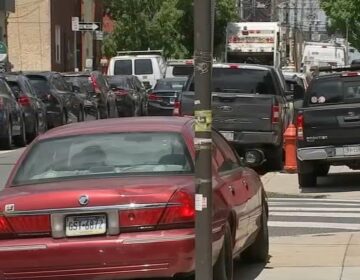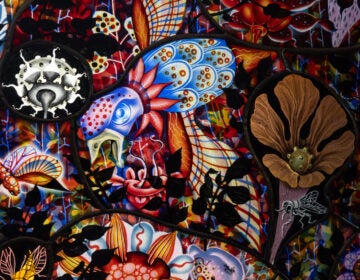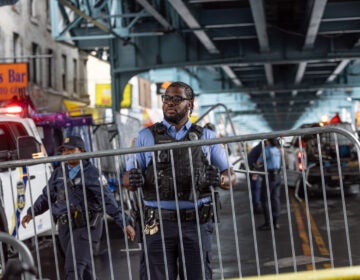27 years of bike race loyalty from Levering Street family
Nearly five decades ago, long before the Philadelphia Bike Race appeared at her front step, Peg Andrews moved into her house on Levering Street with her husband, Anthony.
Sitting on the bench outside of her house at the foot of The Wall on Sunday, Peg realizes that she’s never missed a single race in the competition’s 27-year history.
But much has changed in 27 years, she says. The viewers have changed, the race’s rules have changed, and the Andrews family has grown.
Looking back, she says with certainty, the “first race was the best.”
She recalls the excitement and anticipation that set in at her dinner table as soon as her family first heard that a major bicycle race was coming to town.
She still remembers her husband and their four children deciding to sell hot dogs, pizza and sodas, not to make money, but rather to make friends.
On their ten foot wide sidewalk, they used to set up chairs and tables, and decorated their house and street with banners and posters.
It was a way of getting to know the neighbors, Peg explains. However, back then, she still recognized most of the people on Levering Street who watched the race with her.
For the first five years of the race, the Andrews sold refreshments, up until her husband died.
“This was his big thing, he just liked being out here with the crowd,” she said.
“Oh, how things have changed,” she sighs as she scans the crowd of youthful drinkers, hoping to see a familiar face.
A changed demographic
Her neighbors are now almost all young renters. All except for the two houses where her grown children now live.
Her daughter Janet, lives next door with her husband.
Across the street, her son Anthony Jr., blows into a plastic vuvuzela-type horn, tempting two of Peg’s granddaughters to cross the race barricade so they could play with their uncle and cousins.
Her son Billy, still watches from his mother’s house, where he now lives with his wife Dawn and five-year old daughter, Samantha.
The family says the community’s traditions have changed. Up until three years ago, the informal event known as “the Manayunk Downhill” brought people out to “the Wall” on the Saturday night before the race.
“Guys from the neighborhood would go down the hill on anything with wheels on it that would roll,” Peg recalls, remembering the time her son Anthony Jr. went down the slope on a “little red wagon.”
After her neighbors began promoting the event by distributing flyers, participation ballooned until police shut down the event in the wake of someone getting injured.
This year, Peg saw over 200 police on her street the night before the race, which is more than she has ever seen on a Saturday night in Manayunk.
“I’d rather see [the Manayunk Downhill] than the bike race,” Peg chuckles, as she thinks about all the different contraptions people used to fly down the steep hill.
These days, decorations are scarce. The banners strung across the street have disappeared because the race organizers banned advertisements from the course a few years ago. She remembers how all of the houses used to be covered in posters and pennants.
Whichever bank was sponsoring the race at the time used to give a gift card to any household that put up one of their pennants, which displayed a flag from each race participants’ nation.
Sometimes she used to meet spectators who had traveled from foreign countries to watch the race. “In the first few years we’d meet the different people from the different nations,” she says about the families of racers who had come to her street to watch.
The Andrews family also noticed the lack of a “Sweep Car” this year. The absence of the vehicle which was traditionally decorated with brooms and informed spectators what lap the racers were on, made it difficult to keep track of the race.
The mayor didn’t ride in his motorcycle sidecar, and event sponsors didn’t throw freebies into the crowd from their moving cars.
The race has undoubtedly changed over 27 years. The crowd has changed the most, but the Andrews’ family traditions remain mostly the same.
The traditions
On race day, Peg wakes up and listens for motorcycle sirens as she sips her cup of coffee and eats one of the donuts that she got the night before for her family.
She feeds a half a tranquilizer to her dog Zena, because “otherwise she would bark all day.”
Then the sirens get closer, which she knows means that the men’s race is approaching for the first of ten visits to the dreaded “Wall.”
The first pass lasts about a minute, and Peg smiles, because “that was the best part”. Now the racers will take longer and longer to complete each lap as they grow more tired, which gives Peg a chance to go inside and do a quick household chore.
Her granddaughters need cowbells, so her daughter-in-law, Dawn, takes Megan and Samantha to find some on Main Street.
Each year the Andrews family has to get new cow bells. That’s because the parents hide the noise-makers from the children each year once the race is over, usually never to be found again.
In honor of the pizza and soft drinks that Anthony Sr. used to serve to their neighbors, they eat pizza and homemade meatball subs.
As they’re eating, a drunken fan nearly wanders into their house. Throughout the day, the whole family remains on guard to make sure people aren’t climbing on any of the properties they own, or misbehaving in the alley next door.
As five-year-old Samantha is trying to pop bubbles with a plastic sword, she almost swings it right into the face of a passing Liquor Enforcement officer.
“Careful,” Dawn yells and adds jokingly, “that’s all we need, assaulting a police officer.”
The driest house on the block
After the race is over, a new form of entertainment emerges. As Dawn explains, “Once the police go up the hill, the drunks come falling down” as they are pushed out of the neighborhoods and onto Main Street.
A few amateur cyclists take the opportunity to climb the wall, and although the race is over, the crowd still cheers for those brave individuals.
Billy recalls the early days of the race, when spectators all knew each other. “It used to be more family oriented,” he recalls “like a block party.”
Now, he thinks, the fans focus too much on the alcohol.
“We thought it was gonna be a great thing and it was for a few years, but after a while it got to be too much,” Peg said.
“It was a party back then, but not a drinking party,” Peg says about the Manayunk Downhill.
The Andrews are proud to say that their house “is the driest on the block,” and that back when Anthony Sr. sold refreshments from their home, alcohol was never for sale.
For the family, the crowd outside has changed for the worse. But inside, they preserve and cherish their traditions.
But for Peg Andrews, the anticipation that the Andrews family felt 27 years ago, and the pre-race excitement felt by our entire city, still remains the best part.
WHYY is your source for fact-based, in-depth journalism and information. As a nonprofit organization, we rely on financial support from readers like you. Please give today.




